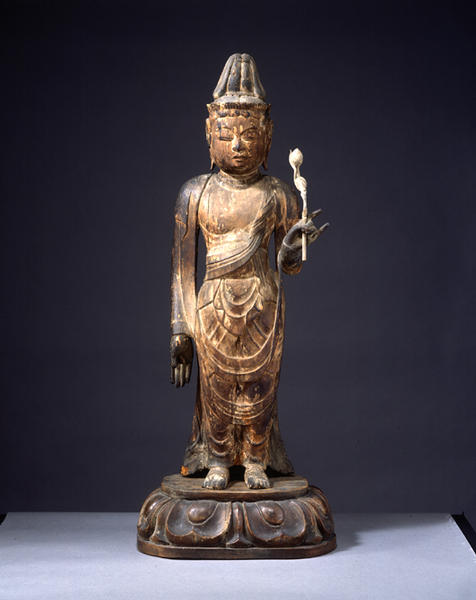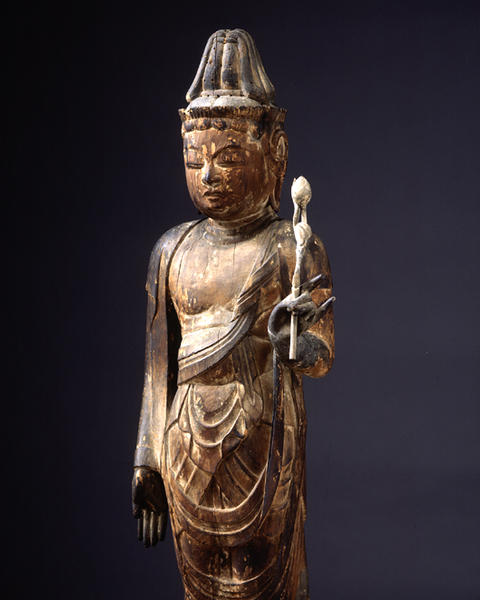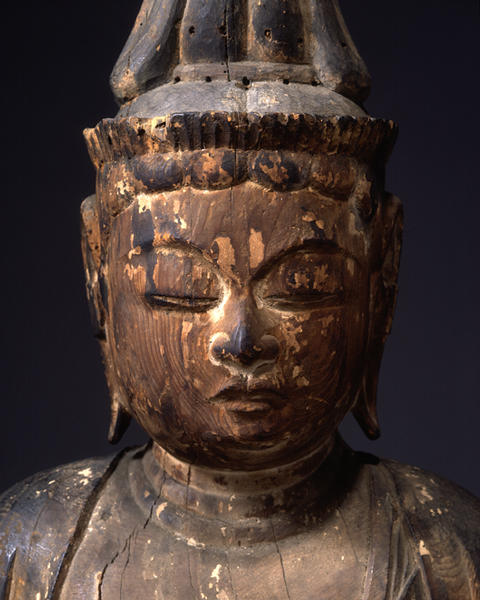菩薩立像
- 平安時代
- 10-11c
- 木造
- H-87.5 W-31
平安時代初期の様式を残す一木造の像である。面相は丸くふっくらとした顔つきで表現され、両肩は強く張り、安定した腰つきを呈している。観音は、大乗仏教で最も広く信仰され、民衆に最も親しまれた菩薩であり、仏の代行者として、救いを求める人々の願いを聞き入れて苦しみから救ってくれる菩薩である。この像は、千手観音や十一面観音など、変化観音と呼ばれる観音の元の姿となる最も基本的な観音で、蓮華を持つのを特徴とする聖観音と思われる。後補の台座は、明治時代の彫刻家、加納銕哉の作で、台座裏には銘文があり、「この像は大阪府の光明寺の本尊で、弘法大師の作と伝えられる」とある。五島美術館のコレクションを蒐集した五島慶太氏の念持仏でもあった。
解説(開館1周年記念展)
像は大きな宝髻を結うやや大きめの頭部,小さめの下半身に対して両肩の張った大きめの上半身をもつプロポーションで,右臂をほぼ真っすぐに伸ばし,掌を前向きに五指を伸ばしている長めの手などに平安前期の風を伝えている。また条帛や裳の折り返し部,および膝前の天衣や裳裾に見られるやや深い衣紋にも,微かに翻波式の名残を留めている。一方,丸い顔には浅い彫りでやや小さめの目鼻を刻んでおり,全体の醸し出す穏やかな印象にも,明確に次期の藤原様式への兆しを感じさせる。このような作風の特徴から,この像は平安時代中期,10世紀も末から11世紀の初頭頃に作られたものと推定される。
元来は白土下地に彩色が施されていたと思われるが,現在は所々にわずかに彩色の痕跡を残すのみである。
左手のひじから下および持物の蓮華,足ほぞを含む両足先,台座は後世のものに変わっている。
Catalogue Entry
The head, body, all of the right arm, upper left arm, and also the separated potion of the cloth draping over the right hand are carved out of a single piece of hinoki (Japanese cypress). (The center of the cypress tree out of which this was carved can be located somewhere behind the back of the head).
This Bodhisattva has a rather large head in proportion to the size of the rest of the body, with the top of the head adorned with a large knot of hair. A large upper body, with wide, prominent shoulders, makes a contrast against the small size of the lower body. This statue has somewhat long arms with its right hand extending straight down, as doing the fingers. The palm of the hand also faces forward. These features suggest a stylistic influence from the early Heian period. Pleats, folded edges, folds, and slightly deep, wrinkled ridges of the robe as seen at the knees are suggestive of the particular style of treatment of flowing robe, called the honpa style, of the previous era, while the shallowly-sculpted round face and small eyes and nose impart a gentle and peaceful impression, a stylistic feature that clearly foreshadows the Fujiwara style of the following era. From these distinctive features, the present image is estimated to have been created in the mid-Heian period between late 10th and early 11th century.
Originally, this image appears to have been finished in polychrome over a white base coat, judging from the remaining traces of coloring on the bottom edge of the robe.
The forearm of the left hand, the lotus flower, the front half of the feet including the mortise and tenon joints, and the pedestal are later additions.


